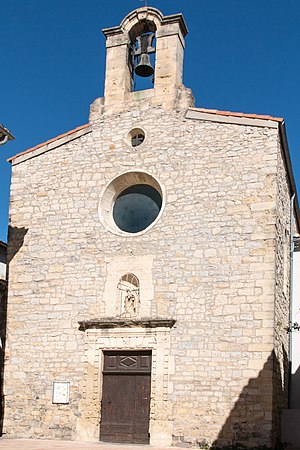Clarensac
| Clarensac | ||
|---|---|---|

|
|
|
| region | Occitania | |
| Department | Gard | |
| Arrondissement | Nîmes | |
| Canton | Saint-Gilles | |
| Community association | Nîmes metropolis | |
| Coordinates | 43 ° 50 ′ N , 4 ° 13 ′ E | |
| height | 42–212 m | |
| surface | 14.49 km 2 | |
| Residents | 4,263 (January 1, 2017) | |
| Population density | 294 inhabitants / km 2 | |
| Post Code | 30870 | |
| INSEE code | 30082 | |
| Website | mairie-clarensac.com | |
 Saint-André church |
||
Clarensac is a French commune with 4263 inhabitants (as of January 1, 2017) in the Gard department of the Occitanie region .
geography
Clarensac is eleven kilometers southwest of Nîmes .
etymology
843, at the time of the Frankish Empire , the place was called Clarentiacum . In 1027 Clarensac was mentioned as Clarensiago . In 1104 it got its current name.
history
In 842 the governor of Septimania gave Clarensac to the Abbaye de Psalmodie at Aigues-Mortes . A little later it belonged to the Counts of Toulouse . Later they gave their lands to the Counts of Nîmes and other minor rulers. In 1075 the lord of the village was called Guillaume de Clarensac , and in 1159 Girard de Clarensac . A later village lord, Guiraud de Clarensac , was knighted in 1248. In 1296 Pons de Clarensac became consul of Nîmes. At that time the village had three churches: Saint-André , Saint-Étienne-d'Alvernes and Saint-Romans . On the bull of Pope Urban IV of December 1156, the churches are not represented as the property of the Nîmes chapter . In 1264 the lord of Uzès sold some parishes to the king, including Clarensac, for an annual pension of two thousand pounds. It is to be assumed that Louis IX. In 1248 and 1270 Clarensac crossed with his cruises on the way to Aigues-Mortes. In fact, some time ago a farmer found the remains of human bones and a cross a foot long. In the time of Ludwig Clarensac was a fortified village with a wall, towers and a castle. The northern entrance, of which remains still exist today, was guarded by a tower that is now the clock tower. The southern gate was guarded by a tower called “de Cazagne”. Guillaume de Nogaret , who supported the French king against Pope Boniface VIII , was rewarded in 1304 with rule over the communities that had previously been ceded to the royal family. That included Clarensac. Although the village was spared the Hundred Years' War , it was invaded again and again by soldiers and Tuchin people . In addition, there was the plague, famine and an earthquake in 1348, which caused a sharp decline in population. The residents of the village later converted to Protestantism. After the victory of the Catholics, a hundred Protestants were killed and a hundred more were arrested. In 1567 the plague returned. During the French Revolution , on August 12, 1789, a vigilante group was founded in Clarensac. In 1830 a Protestant church was built. In the 19th century the community was dominated by agriculture, mainly wine and olive growing. Towards the end of the century, the appearance of phylloxera forced many people to move to Nîmes or to work in the mines of La Grand-Combe . In 1907, many winemakers took part in the winemaker rebellion in Nîmes and Montpellier . In 1910 Clarensac was connected to the power supply, in 1925 the local winegrowers' cooperative was built, another followed in 1937.
Culture and sights
- Clock tower (former watchtower)
- Fontaine du Griffe (fountain)
- Towers and old city walls, old village center
- Côte de Clarensac (slope of Clarensac), highest point of the Vaunage
Population development
| year | 1962 | 1968 | 1975 | 1982 | 1990 | 1999 | 2008 | 2017 |
| Residents | 448 | 532 | 727 | 1597 | 2208 | 2654 | 3628 | 4263 |
